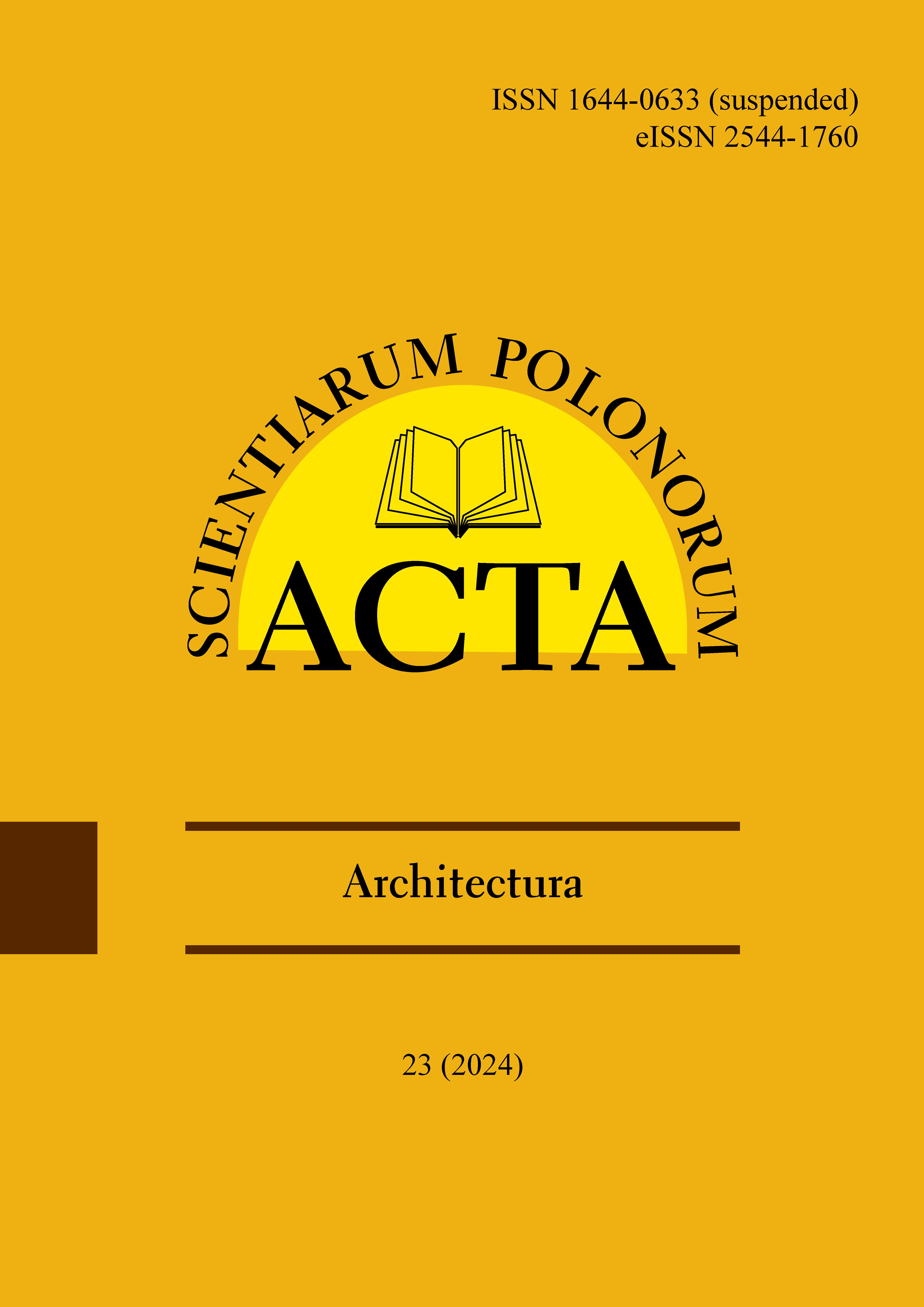Main Article Content
In this article, the authors raise issues of dualistic solutions in urban design and city development. It should be noted at the outset that the very concept of duality is not obvious and is inherently ambiguous. The numerous definitions that exist are very general. We can distinguish several disciplines and scientific areas where the concept of dualism occurs or can appear. At the same time, the definition of each of these phenomena will be different, depending on the area in which it occurs. Hence, the authors have made a far-reaching reduction in the types of dualisms, narrowing the area of research to the creative attitudes of urban planners, philosophers of space, artists, and architects in historical terms. The aim of the search for dual features in spatial forms is to find the key to a better understanding of the laws governing urban planning and urbanisation processes. Verification of opposites and dual characteristics takes place on three levels: community, form, and function. The urban conditions that occur contribute to the creation of new qualities and new spatial forms, which help redefine the city and its development. The paper is based on the thesis that dualism is a permanent feature of spatial solutions (a recurring feature) across the spectrum of history.
Article Details
Alexander, C. (1973). Notes on the Synthesis of Form (4th ed.). Cambridge, MA: Harvard University Press, p. 10.
Alexander, C. (2015). A City Is Not a Tree (50th ed). Portland, OR: Sustasis Press, Sustasis Foundation, p. 57.
Banham, R. (1960). Theory and Design in the First Machine Age. London: Architectural Press, pp. 189, 247, 251–252.
Berg, C. (2006). Erziehungswissenschaftliche Anerkennungen zum Generationsbegriff. Forum, 259, p. 31.
Bollnow, O. F. (1963). Mensch und Raum. Stuttgart: Kohlhammer Verlag.
DBT/Melde (2015). Christo-Sammlung zum verhüllten Reichstag 1995 [photography]. Retrieved from: https://www.bundestag.de/webarchiv/textarchiv/2015/kw47-christo-395996 [accessed: 22.06.2022].
Descartes, R. (1685). Principia philosophiae. Amsterdam.
Florida, R. (2019). The Rise of the Creative Class. Basic Books: New York, pp. 28–32.
Giedion, S. (1967). Space, Time and Architecture: The Growth of a New Tradition. Cambridge, MA: Harvard University Press.
Giorgio Martini, F. di (c. 1470). Fortified Man [illustration from Trattato di architettura]. Turin Biblioteca Reale. Retrieved from: https://scx1.b-cdn.net/csz/news/800a/2022/hearts-cells-and-mud-h-1.jpg [accessed: 22.06.2022].
Gropius, W. (1962). The Scope of Total Architecture. New York: First Collier Books.
Hall, E. T. (1990). The hidden dimension. New York: Anchor Books.
Heidegger, M. (1994). Bauen Wohnen Denken. Köln: Vorträge und Aufsätze.
Heller, M. (1993). Fizyka ruchu i czasoprzestrzeni. Warszawa: PWN.
Hildebrandt-Wypych, D. (2009). Pokolenia młodzieży – próba konceptualizacji [Youth generations – an attempt at conceptualization]. Przegląd Pedagogiczny, 2, 105–124.
Huntington, S. P. (2011). The Clash of Civilizations and the Remaking of World. New York: Order Simon & Schuster, pp. 42–48, 54–56.
Jammer, M. (1957). Concepts of Space. The History of Theories of Space in Physics. Cambridge, MA: Harvard University Press.
Jencks, C. (1973a). Modern Movements in Architecture. New York: Anchor Press, pp. 368–372.
Jencks, C. (1973b). Le Corbusier and the Tragic View of Architecture. Middlesex: Allen Lane, pp. 114–118.
Jencks, C. (2011). The Story of Post-Modernism. London: John Wiley &Sons, pp. 27, 56–58.
Jencks, C. & Kropf, K. (2006). Theories and Manifestoes of Contemporary Architecture. Chichester: Wiley-Academy, pp. 286–287.
Kant, I. (1957). Krytyka czystego rozumu. Warszawa: PWN.
Lynch, K. (1960). The Image of the city. Cambridge, MA: Massachusetts Institute of Technology.
More, T. (1912). Utopia. London: The Macmillan Company, The Second Book.
Norberg-Schulz, C. (1971). Existence, space and architecture. New York: Praeger Publishers.
Norberg-Schulz, C. (2000). Bycie, przestrzeń i architektura. Warszawa: Murator.
Pevsner, N. (1936). Pioneers of the Modern Movement from William Morris to Walter Gropius. London: Faber and Faber, pp. 142, 146–149.
Reale, G. (1990). A History of Ancient Philosophy. Vol. 2. Plato and Aristotle. New York: State University of New York Press.
Rewers, E. (2005). Post-polis: wstęp do filozofii ponowoczesnego miasta. Kraków: Towarzystwo Autorów i Wydawców Prac Naukowych Universitas.
Sadler, S. (2005). Archigram: Architecture without architecture. Cambridge MA: Massachusetts Institute of Technology Press, p. 47. (Crossref)
Sennett, R. & Jankowska, H. (2009). Upadek człowieka publicznego. Warszawa: Wydawnictwo Muza.
Sennett, R. & Konikowska, M. (1996). Ciało i kamień. Człowiek i miasto w cywilizacji Zachodu. Gdańsk: Wydawnictwo Marabut.
Seuphor, M. (1956). Piet Mondrian Life and work. New York: H.N. Abrams.
Venturi, R. (1966). Complexity and Contraddiction in Architecture. New York: The Museum of Modern Art.
Wallis, A. (1979). Informacja i gwar. Warszawa: Państwowy Instytut Wydawniczy.
Zarębska, T. (1970). Teoria urbanistyki włoskiej XV I XVI wieku. Warszawa: PWN.
Znaniecki, F. (1938). Socjologiczne podstawy ekologii ludzkiej. Ruch Prawniczy, Ekonomiczny i Socjologiczny, 18 (1), 89–119.
Downloads

This work is licensed under a Creative Commons Attribution-NonCommercial 4.0 International License.

